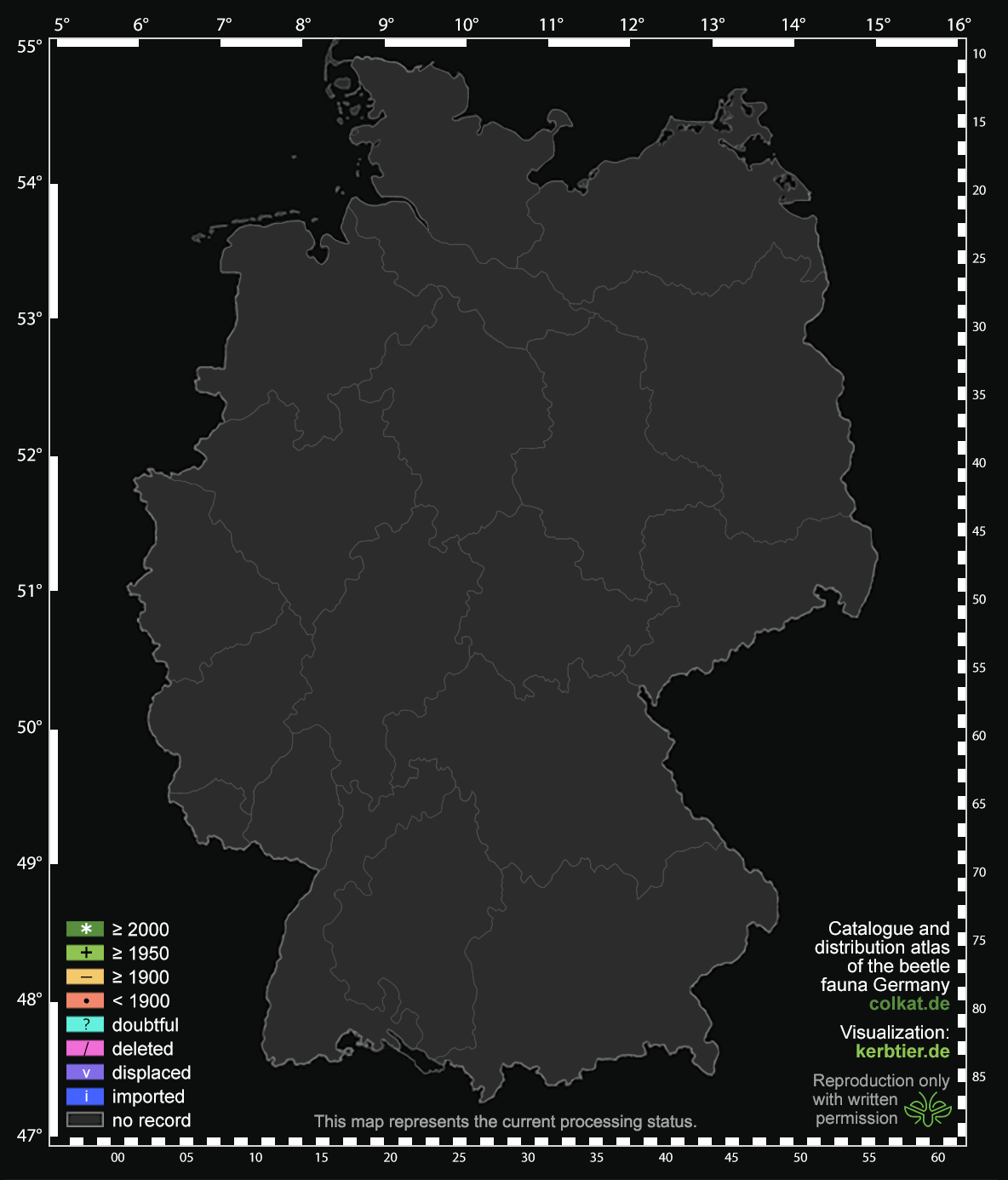View answered requests for beetle ID
|
|
On this page you can find photos submitted by users from the start in 2012 till the shutdown in 2023. If possible, the species are identified by the kerbtier.de ID team. Sometimes determination by photo only is impossible, in this case a hint on family and genus and potential species will be given.
|
|

|
|

|
|
|
|
Submitted by, on:
 558 558
 246 246

Manfred  2016-02-20 10:00 2016-02-20 10:00

Country, map sheet, date (discovery):
 DE
DE
 7115 Rastatt (BA)
7115 Rastatt (BA)

 2013-08-03
2013-08-03
Request: Hallo, liebes Käferteam,
ein Corymbia rubra ♂, Größe ca. 17 mm, gefunden am 3.8.2013 am Ortsrand von Niederbühl/Rastatt.
Vielen Dank und viele Grüße,
Manfred
Species, family:
 Corymbia rubra
Corymbia rubra
 Cerambycidae
Cerambycidae
Comment: Hallo Manfred, bestätigt als Corymbia rubra Männchen (Weibchen sind rot, daher auch der Name). Die Larve entwickelt sich in Nadelholz. Danke für die Meldung. Viele Grüße, Holger
Last edited by, on:  HK  2016-02-20 10:10 2016-02-20 10:10
|
|
|
|
Submitted by, on:
 48 48

Günther  2016-02-20 08:58 2016-02-20 08:58

Country, date (discovery):
 Austria
Austria

 No date of discovery found. Please contact webmaster! No date of discovery found. Please contact webmaster!
Request: Guten Tag,
der Fundort ist in Österreich an der Donau hinter Linz in Richtung Wien. Zur Zeit der Aufnahme lag die Stelle im Schatten. Die Käfer befanden sich zum größten Teil auf eine Distelart.
Gruß Günther und danke vorab
Species, family:
 Sphaeroderma
Sphaeroderma cf. testaceum
 Chrysomelidae
Chrysomelidae
Comment: Hallo Günther, das ist wahrscheinlich Sphaeroderma testaceum. Diese Art bevorzugt Disteln und S. rubidum Flockenblumen. Absolute Kostverächter sind sie aber wohl andersrum auch nicht, daher nicht ganz sicher. Man erkennt weder die Körperform, noch die Punktierung, noch die Fordertarsen, daher setze ich ein cf.. Viele Grüße, Holger
Last edited by, on:  HK  2016-02-20 10:08 2016-02-20 10:08
|
|
|
|

Bert1958  2016-02-19 12:41 2016-02-19 12:41

Country, date (discovery):
 Netherlands
Netherlands
 2012-05-19
2012-05-19
Request: 19-05-2012, beobachtet in unserem hintergarten
Species, family:
 Dorytomus longimanus
Dorytomus longimanus
 Curculionidae
Curculionidae
Comment: Hallo Bert, die auffällig langen Vorderbeine verraten ein Männchen von Dorytomus longimanus. Um die Jahreszeit wohl gerade frisch geschlüpft. Fast in der ganzen Paläarktis, nicht in Nordeuropa. Auf Pappeln, ab dem zeitigen Frühjahr zu finden und häufig. Gruß, Lennart
Last edited by, on:  LW  2016-02-19 14:17 2016-02-19 14:17
|
|
|
|
Submitted by, on:
 48 48
 82 82

margina  2016-02-19 13:55 2016-02-19 13:55

Country, map sheet, date (discovery):
 DE
DE
 7935 München-Solln (BS)
7935 München-Solln (BS)

 2016-02-18
2016-02-18
Request: Am 18.02.2016 Totfund im Keller. Ca. 1,4 cm groß. Ist dieser schöne Käfer noch zu bestimmen?
Vielen Dank und Gruß!
Species, family:
 Phymatodes testaceus
Phymatodes testaceus
 Cerambycidae
Cerambycidae
Comment: Hallo margina, das ist der Bockkäfer Phymatodes testaceus. In Europa, Kleinasien, Kaukasus, Nordafrika. Eingeschleppt nach Nordamerika. Entwickelt sich in Laubhölzern, vor allem Eiche und Buche. Gruß, Lennart
Last edited by, on:  LW  2016-02-19 14:15 2016-02-19 14:15
|
|
|
|
Submitted by, on:
 223 223
 14 14

WolfgangL  2016-02-19 01:21 2016-02-19 01:21

Country, map sheet, date (discovery):
 DE
DE
 7835 München (BS)
7835 München (BS)

 2016-02-19
2016-02-19
Request: Guten Abend, im Botanischen Garten München gibt's zurzeit die Schmetterlingsschau. In einem Gewächshaus fliegen Falter aus Costa Rica, Surinam und Thailand (wenn ich das richtig im Kopf habe). Heute fand ich dort diesen Käfer, den ich als Plagionotus arcuatus bestimmen würde. Liege ich da richtig? Falls ja: Wie kommt dieser Käfer in ein Gewächshaus mit tropischen Pflanzen? Die einzige Erklärung, die mir plausibel scheint, wären die Holzstücke, an denen die angelieferten Puppen aufgehängt werden. Die sind vermutlich von einer Korkeiche, das könnte doch passen! Oder kann das eine exotische Art sein, die versehentlich mitgeliefert wurde?
Viele Grüße,
Wolfgang
Species, family:
 Plagionotus arcuatus
Plagionotus arcuatus
 Cerambycidae
Cerambycidae
Comment: Hallo Wolfgang, bestätigt als Plagionotus arcuatus, der Fund ist allerdings interessant. Plausibel klingt nur deine Annahme, dass die Tiere mit Korkeiche eingeschleppt wurden. Oder aber die Art kommt im Botanischen Garten auch so vor und ein paar Tiere haben es im Frühjahr in das Gewächshaus geschafft. Es gibt auch exotische Vertreter der Gattung, davon ist es jedoch keiner. Viele Grüße, Thomas
Last edited by, on:  TH  2016-02-19 12:52 2016-02-19 12:52
|
|
|
|
Submitted by, on:
 556 556
 174 174

Manfred  2016-02-19 09:16 2016-02-19 09:16

Country, map sheet, date (discovery):
 DE
DE
 7216 Gernsbach (BA)
7216 Gernsbach (BA)

 2013-05-05
2013-05-05
Request: Hallo, liebes Käfereteam,
ein Agrypnus murina auf der vordersten Spitze eines Brennnesselblattes, Größe ca. 15 mm, gefunden am 5.5.2013 in einem Seitental der Murg bei Gernsbach.
Vielen Dank und viele Grüße,
Manfred
Species, family:
 Agrypnus murina
Agrypnus murina
 Elateridae
Elateridae
Comment: Hallo Manfred, bestätigt als Agrypnus murina. Danke für die Meldung. Gruß, Lennart
Last edited by, on:  LW  2016-02-19 11:58 2016-02-19 11:58
|
|
|
|
Submitted by, on:
 555 555
 17 17

Manfred  2016-02-19 09:13 2016-02-19 09:13

Country, map sheet, date (discovery):
 DE
DE
 7115 Rastatt (BA)
7115 Rastatt (BA)

 2016-02-18
2016-02-18
Request: Hallo, liebes Käferteam,
ein Dromius quadrimaculatus, Größe ca. 6 mm, gefunden am 18.2.2016 unter einem losen Stück Platanenrinde im Park von Schloss Favorit bei Rastatt.
Vielen Dank und viele Grüße,
Manfred
P.S. gibt es möglicherweise einen Tipp für den Winzling daneben?
Species, family:
 Dromius quadrimaculatus
Dromius quadrimaculatus
 Carabidae
Carabidae
Comment: Hallo Manfred, bestätigt als Dromius quadrimaculatus. Danke für die Meldung. Das daneben müsste zu den Läusen gehören. Unverbindlicher Tipp: Familie Liposcelididae. Gruß, Lennart
Last edited by, on:  LW  2016-02-19 11:58 2016-02-19 11:58
|
|
|
|
|
|
|
|
|
|
|
|
Submitted by, on:
 644 644

Lennart Bendixen  2016-02-17 21:47 2016-02-17 21:47

Country, map sheet, date (discovery):
 DE
DE
 1324 Süderbrarup (SH)
1324 Süderbrarup (SH)

 2015-06-27
2015-06-27
Request: 5 mm, 27.06.2015, Garten, unter einem Stein. Staphylinidae? Vielen Dank & schöne Grüße, Lennart
Species, family:

Unknown
Comment: Hallo Lennart, dieses Tierchen haben jetzt alle Admins gesehen und da ALLE superhartnäckig schweigen, bleibt mir nichts anderes übrig, als Unknown draus zu machen. LG, Christoph
Last edited by, on:  CB  2016-02-18 20:02 2016-02-18 20:02
|
|
|
|
Submitted by, on:
 210 210
 10 10

moppedopa  2016-02-18 16:03 2016-02-18 16:03

Country, map sheet, date (discovery):
 DE
DE
 5512 Montabaur (RH)
5512 Montabaur (RH)

 2010-03-30
2010-03-30
Request: Hallo.
Diese Bilder habe ich vor 6 Jahren (laut EXIF am 30.03.2010) gemacht,
also als ich noch nicht ahnen konnte, dass mir das fotografieren von Käfern Spaß machen würde.
Ich weiß noch, dass es in unserem Garten in Hilgert/WW war. Größe kann ich nicht mehr sagen.
Ist der Rüssler bestimmbar?
Gruß,
Stefan
Species, family:
 Otiorhynchus salicicola
Otiorhynchus salicicola
 Curculionidae
Curculionidae
Comment: Hallo moppedopa und Coadmins, ich halte das Tier für einen männlichen O. salicicola, möchte mich aber nicht festlegen, da von der Körperoberfläche nahezu nichts erkennbar ist. Vlt. bestätigt jemand den noch. VG Thomas Seh ich auch so. Ein Adventivart, die erst seit ca. 10 Jahren in Deutschland gefunden wird. Viele Grüße, Michael Seh ich auch so und wir nehmen das cf. weg. LG, Christoph
Last edited by, on:  CB  2016-02-18 19:59 2016-02-18 19:59
|
|
|
|
|
|
|
|
|
|
|
|
|
|
|
|
Submitted by, on:
 553 553

Manfred  2016-02-18 09:34 2016-02-18 09:34

Country, map sheet, date (discovery):
 DE
DE
 7216 Gernsbach (BA)
7216 Gernsbach (BA)

 2014-04-04
2014-04-04
Request: Hallo, liebes Käferteam,
ein Dasytes aeratus, vermute ich, Größe ca. 5 mm, gefunden am 4.4.2014 an einer Hauswand in Murgnähe bei Gaggenau-Ottenau.
Vielen Dank und viele Grüße,
Manfred
Species, family:
 Dasytes
Dasytes cf. aeratus
 Melyridae
Melyridae
Comment: Hallo Manfred, ich vermute auch Dasytes aeratus. 100% sicher an diesem einen Foto bin ich nicht. Vielleicht mag sich jemand anderes festlegen. Viele Grüße, Michael
Last edited by, on:  MS  2016-02-18 18:27 2016-02-18 18:27
|
|
|
|
Submitted by, on:
 211 211

moppedopa  2016-02-18 16:11 2016-02-18 16:11

Country, map sheet, date (discovery):
 DE
DE
 5511 Bendorf (RH)
5511 Bendorf (RH)

 2015-08-02
2015-08-02
Request: Hallo.
Habe diesen Melyridae am 02.08.15 bei uns im Garten in Bendorf gesichtet.
Ist er bestimmbar? Ich vermute aufgrund des unscharfen Fotos eher nicht.
Mein Tip währe Dasytes virens.
Ca. 4-5 mm.
Beste Grüße,
Stefan
Species, family:
 Dasytes
Dasytes cf. plumbeus
 Melyridae
Melyridae
Comment: Hallo moppedopa, das ist wahrscheinlich eher ein Weibchen von Dasytes plumbeus. Halsschild glänzt zu sehr und man erkennt eine Andeutung von Gelb, da wo die Vorderhüften sind. 100% sicher allerdings nicht. Viele Grüße, Michael
Last edited by, on:  MS  2016-02-18 18:17 2016-02-18 18:17
|
|
|
|
Submitted by, on:
 185 185
 135 135

moppedopa  2016-02-18 15:20 2016-02-18 15:20

Country, map sheet, date (discovery):
 DE
DE
 5511 Bendorf (RH)
5511 Bendorf (RH)

 2015-07-14
2015-07-14
Request: Aphidecta obliterata?
Fundort: Rheinufer in Bendorf
Funddatum: 14.07.15
Species, family:
 Adalia decempunctata
Adalia decempunctata
 Coccinellidae
Coccinellidae
Comment: Moin moppedopa, für Aphidecta stimmt der Habitus nicht, auch wenn die Färbung sehr verführerisch ist. Ich denke, dass wir es hier mit einer der vielen Variationen von Adalia decempunctata zu tun haben, lasse aber die anderen noch mal drauf linsen. Viele Grüße, Klaas
Last edited by, on:  KR  2016-02-18 17:51 2016-02-18 17:51
|
|
|
|
|
|
|
|
|
|
|
|
|
|
|
|
|
|
|
|
Submitted by, on:
 182 182
 71 71

moppedopa  2016-02-18 15:15 2016-02-18 15:15

Country, map sheet, date (discovery):
 DE
DE
 5511 Bendorf (RH)
5511 Bendorf (RH)

 2015-07-27
2015-07-27
Request: Hallo.
Ich habe die letzte Zeit mal dazu genutzt, die Bilder meiner Coccinellidae,die ich im laufe des letzten Jahres gemacht habe zu sortiren und versucht, die Art zu bestimmen.
Bei einigen bin ich mir sicher, aber aufgrund der enormen Farbvariationen mancher Arten kann ich aber auch vollkommen daneben liegen. Ich denke aber, für Euch wird das kein Problem sein. Danke im Voraus.
Beginnen wir also.
Anatis ocellata?
Fundort: Rheinufer in Bendorf
Funddatum: 27.07.15
Species, family:
 Anatis ocellata
Anatis ocellata
 Coccinellidae
Coccinellidae
Comment: Hallo moppedopa, bestätigt als Anatis ocellata. Danke für die Meldung. Viele Grüße, Thomas
Last edited by, on:  TH  2016-02-18 17:17 2016-02-18 17:17
|
|
|
|
|
|
|
|
|
|
|
|
|
|
|
|




